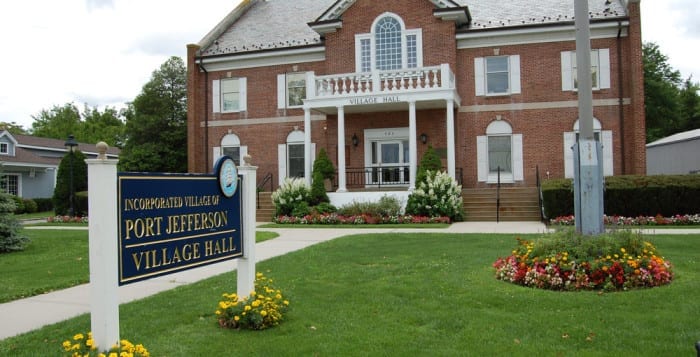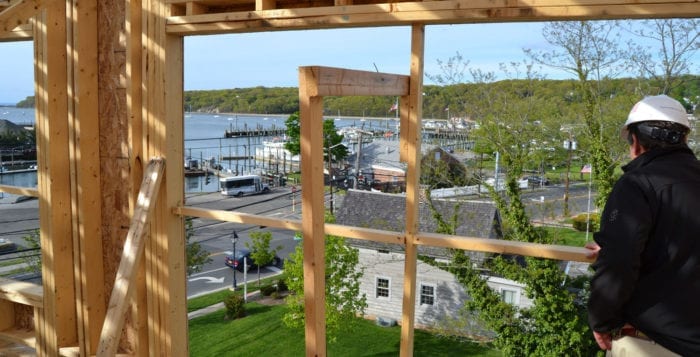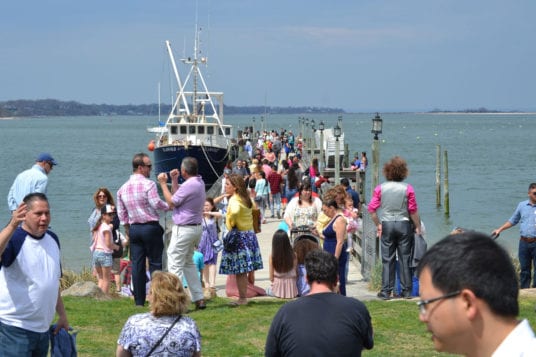By Alex Petroski
The terms of two Port Jefferson Village board trustees and the mayor are up this year and an election awaits them June 20, but in a race devoid of actual opponents, those up for reelection have opposition in the form of difficult, long-range challenges to square off against instead.
Barring a groundswell of support for a potential write-in candidate, incumbent trustees Stanley Loucks and Larry LaPointe, as well as incumbent Mayor Margot Garant know they’ll be serving the community for another two-year term after the election.
Garant will embark on her fifth term in office, while Loucks is set to begin his second and LaPointe his fourth.

With long-term issues looming, like large-scale apartment developments and an ongoing legal battle with the Long Island Power Authority, Garant said a focus of her first four terms has been to bolster the village’s sources of revenue in any way possible. Beautification projects funded in large part by state and county grants are underway in upper Port, the area surrounding the Long Island Railroad station, in an effort to get blighted and vacant properties back on the village’s tax roll and attract private investors to build in the area.
“I really wanted to make sure that we …had a beautiful new gateway on the south side of the village that made you feel like you were entering the village of Port Jefferson in upper Port,” Garant said. “I think we owe that to the upper Port community.”
Loucks, who serves as the board’s liaison to the village-owned Port Jefferson Country Club and to the village’s recreation department, said his focus has been on improving and building up each of those village assets in the hopes of attracting members and village participation — another source of village revenue. About $100,000 of tax dollars were invested to improve the golf course’s village-owned grill room, which Loucks said is now an asset for the club.
“This year alone our membership, for the first time since I’ve been involved … is up,” Loucks said during the May 25 interview. “We’ve had a decline in membership over the past 10 years. Approximately 50 members per year on average have left us either through attrition or they’ve passed away or they’ve moved away or gone to other clubs. This year we’re up.”
LaPointe, the deputy mayor, was someone Garant pointed to as a possible successor when she decides to step away.
“I’m happy to see Margot in that chair because I think she’s been a wonderful mayor,” he said in an interview. “I get a lot of personal satisfaction out of this and that’s why I continue to do it.”
All three incumbents surmised that a lack of challengers could serve as proof residents are happy with the job the board is doing. Garant explained that the platform of the Unity Party, the name the three have attributed to their joint ticket, is to do what’s best for the community. The result has been a board that has a positive and productive rapport, according to Garant.
“We may not always agree, but we’ll always be able to listen. We’ll try and compromise, but largely we’re not on opposite pages,” she said. “I think if you put your self-interests aside and say, ‘What’s in the best interest of the village?’ we’ll all get there together. I think that that’s how
we survived.”
Trustee Bruce Miller, who Garant said tends to have differing opinions from the rest of the board at times, said in a phone interview he wished his colleagues faced some opposition because it would be a chance for different viewpoints from the community to be brought to the forefront.
“There are some ideas that I have, but there’s nobody to bring these ideas forth,” he said. “I’m not completely thrilled, but at some level it does reflect some contentment in what’s going on.”
He reiterated that the working relationship within the board is overwhelmingly positive.
Bruce D’Abramo, the fifth member of the board, said in an email he fully supports Garant, Loucks and LaPointe in their reelection bids.
LaPointe expressed a similar sentiment regarding varying viewpoints from residents being heard and represented.
“I think in a way it’s a disadvantage because when we run with an opponent, which we’ve done several times, it forces us to take the time to go and knock on doors, and the last time we found that very, very fruitful,” he said. “I want to talk to some people other than the people who typically come to board meetings.”
Each of the three candidates expressed a desire to see solutions to some of the more difficult problems through to the end before stepping aside.
A lawsuit is currently pending that includes the village and the Port Jefferson School District as plaintiffs against LIPA, associated with the power authority’s desire to pay less in property taxes at sites like the Port Jefferson power plant because of its condition and infrequent use. The village and district receive substantial amounts of revenue from property taxes because of the presence of the plant.

Garant said in an interview in her office May 25 the village will continue to build up its unencumbered fund balance as a savings to use in the event a settlement is reached between the two parties that results in a loss of revenue for the village. The plan is to reach an agreement with LIPA with a gradual reduction in their property taxes, should the village’s first choice of repowering the plant not happen.
In addition, three apartment complexes in the village are at various stages of completion, which will in total result in nearly 300 new living spaces for new village residents. The expansion is expected to stimulate local businesses, but could wreak havoc on the school district should renters with school-aged children flood the homes, with little gain in property tax revenue because of financial assistance agreements reached between the property developers and the Suffolk County Industrial Development Agency.
The village will receive PILOTs, or payments in lieu of taxes, for 15 years instead of actual property tax revenue thanks to the agreements.
For example, The Shipyard apartment complex being constructed by TRITEC Development Group, across from Port Jefferson Harbor on the corner of East Broadway and Barnum Avenue, would net the village about $49,000 in property tax revenue in 2025, according to Garant. Thanks to the agreement, the PILOT payments in that year will amount to about $3,000. Garant estimated the losses for the village to exceed a half a million dollars by 2030. She said she and the board opposed the agreement between the Suffolk IDA and TRITEC. However, building permits and other fees written into the village code will serve to offset a small portion of those costs, Garant added.
Increased traffic and the sheer size of the projects have also caused angst among some longtime village residents.





































